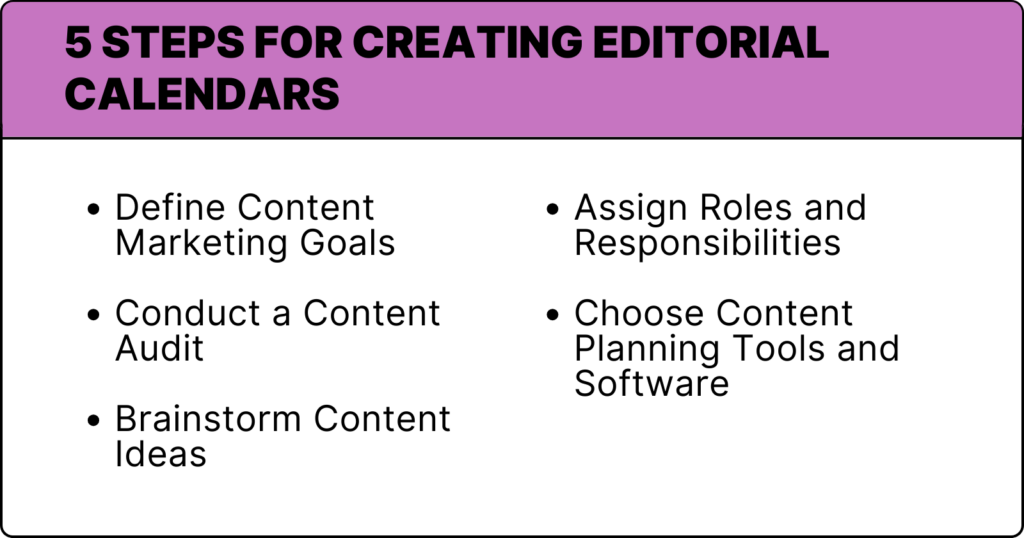The calendar is an unsung hero in life. It creates order, signals the seasons, gives us our bearings and helps us be in the right place at the right time. And for brand publications, a content marketing editorial calendar helps you be focused, productive and on point. Without a good calendar, your content strategy will be confused — and your employees will be, too.
A good editorial calendar serves as the flight plan for your content strategy, aligning your marketing initiatives with your business goals and target audience. It keeps everyone informed about what content to publish, when, where and by whom. In this article, we’re discussing what goes into the perfect editorial calendar.
Benefits of an Editorial Calendar in Content Marketing
Let’s start by considering the purpose of an editorial calendar and some of the benefits for content teams.
- Streamlines content creation and publication: An editorial calendar provides a clear publication framework and schedule. Timely, coordinated delivery replaces last-minute rushes.
- Ensures content consistency and quality: An editorial calendar helps you publish consistently rather than in fits and starts. This is especially important in content marketing, where you don’t necessarily have a news hook to drive your content output. An editorial calendar also informs content quality — planning allows for better research, writing and production.
- Facilitates strategic planning and alignment with business goals: A well-structured editorial calendar aligns your content with broader goals, starting with marketing and sales. A proper calendar helps connect content to the right audience, including around industry events, seasonal themes and promotional campaigns.
- Fosters teamwork, collaboration and communication: An editorial calendar is the single source of truth for planning, tracking and communicating your content goals. It’s the place to go for content producers, designers, marketing leaders, subject matter experts and more. It clarifies roles and responsibilities, aligning everyone on common goals.
- Structures performance reporting: An editorial calendar sets a cadence for performance monitoring and analysis, allowing for ongoing content strategy refinement based on key metrics.
What Does an Editorial Calendar Look Like?
An effective editorial calendar doesn’t need to be overly complex. But it should cover a handful of crucial elements, even on small teams.
Content Themes, Topics and Types
Content is the foundation of your editorial calendar, but you can’t wet your finger, hold it in the air and see which way the content wind is blowing. Instead, start by identifying the main themes and topics that align with your organization’s mission, values and target audience. If you’re working at an agency, apply the same principle to your clients.
Themes are the big buckets, under which you fit related topics. With themes, you go wide; with topics, you go deep. Next, decide which platforms to engage the audience using a mix of formats, such as blog posts, images, videos, podcasts and social media updates.
Publishing Schedule and Frequency
Create a publishing schedule once you have mapped out your content themes and types. The timeline should specify when and how often to publish each piece of content. Consistency is key — aim to maintain a cadence your audience can rely on and that your team can deliver.
Consider your team’s capacity, audience preferences and overall marketing goals. For instance, you might plan to publish a blog post every Monday, a video every other Wednesday and a podcast episode once a month — all supported by social media posts and promotion in your email newsletter. Be realistic. It’s better to publish slightly less often so you can sustain a schedule over the long haul.
Content Production Ownership
Assigning clear ownership and responsibilities is crucial for executing your editorial calendar smoothly and consistently. Each piece of content should have a designated owner for key tasks. Who will write a blog post? Who will produce and moderate a webinar? Who’s designing the images? Who’s the final sign-off on all (or most) content?
Distribution Channels
Your editorial calendar should also specify distribution channels, including owned media (your website, blog, email list and social media profiles), earned media (press coverage, guest posts and influencer partnerships) and paid media (sponsored content, social media ads and search engine advertising).
Also, consider how to repurpose your content for other channels. For example, turn a blog post into a series of social media updates or transform a webinar recording into short video clips for YouTube or TikTok.
Performance Metrics and Goals
Set key performance metrics (KPIs) for each piece of content to effectively measure the success of your editorial calendar and continually optimize your content strategy. Align content marketing KPIs with your overall business objectives, tailoring them to the content format and distribution channel.
Some common KPIs for content marketing include:
- Website traffic: The number of visitors to your content pages.
- Engagement: Likes, comments, shares and time spent on page.
- Lead generation: Email sign-ups, contact form submissions or other lead magnet downloads.
- Conversions: Sales, registrations or other desired actions taken due to the content.
Set specific, measurable goals for each KPI, and track progress over time. Review your content performance regularly against business goals, and adjust your editorial calendar accordingly.

5 Steps for Creating Editorial Calendars
Define Content Marketing Goals
Creating an editorial calendar involves a systematic and collaborative process. The first step is to define your content marketing goals, which should align with your overall business strategy. Sometimes these are called objectives and key results, or OKRs.
Identify your target audience, determine the desired outcomes (e.g., brand awareness, lead generation or customer retention) and set measurable KPIs.
Conduct a Content Audit
Next, conduct a content audit to assess your existing content assets and identify gaps or improvement opportunities. An audit helps you determine which content types to rely on and which themes or topics to focus on. When possible, look at historical data for clues into what content resonates with your audience.
Brainstorm Content Ideas
Once you clearly understand your goals and content needs, brainstorm editorial calendar ideas. Involve key stakeholders from marketing, sales, customer service and product development. If you work at a brand, tap into subject matter experts to unlock valuable ideas that drive your business but might be difficult to communicate to prospective buyers.
Such collaboration provides diverse perspectives and ensures your content addresses your target audience’s needs and interests. Use techniques like mind mapping, SEO keyword research and competitor analysis to generate relevant and engaging content ideas.
Prioritize and organize content based on relevance, urgency and feasibility. When planning your calendar, consider factors such as seasonal trends, upcoming events, product launches and marketing campaigns. These factors are especially important for thought leadership content.
Assign Roles and Responsibilities
Editorial calendars are powerful, but they don’t do anything without people being assigned to roles and responsibilities. During this step, clarify deadlines, and establish workflows for content creation, editing and approval.
Creating and managing a content marketing editorial calendar is a collaborative effort that involves various stakeholders across the organization. Here are some of the key roles you’ll see on content marketing teams:
- Content strategists. These individuals develop the content strategy, including content themes and topics. They help align content with business goals and audience needs.
- Content creators. This group includes writers, editors, designers, videographers and other creative professionals who produce content pieces based on the editorial calendar. This also includes anyone who reviews, edits or approves content. There might be an additional layer of review to ensure alignment with brand guidelines, marketing goals or legal requirements.
- Marketing and promotion. These people plan and execute content distribution and promotion strategies, including social media, email marketing and paid advertising.
- Project managers. They oversee the content creation process, assign tasks, monitor deadlines and ensure collaboration among team members.
- Subject matter experts. These individuals, often from product development, customer service or sales, provide insights and expertise to enrich content and ensure accuracy.
- Analytics. Your analytics professionals monitor content performance, provide data-driven insights and recommend optimizations based on audience engagement and conversion metrics.
Note that on many teams, one person might wear multiple hats. Content marketing managers, for example, might do all of these tasks at one time or another.
Choose Content Planning Tools and Software
An editorial calendar can live in a spreadsheet or on Google Calendar, but it can also be part of a more robust project management system used across your organization, such as Trello or Asana. On some teams, physical calendars or whiteboards can be effective, especially during brainstorming sessions or to highlight immediate publication needs during an in-person meeting.
Whatever tools or software you choose, consider the most essential features for your team, such as collaboration capabilities, task assignments and integration with other marketing tools. This is also a good time to examine the content management system (CMS) you’re using to publish material.
Related resource: Stop Using Excel! The Best Editorial Calendar Tools to Use

Best Practices for Effective Editorial Calendars
Determine Your Philosophy
It may sound odd to imagine your publication schedule needs a philosophy, but thinking philosophically ensures that the content marketing editorial calendar is rooted in strategic alignment, consistency and flexibility. It should be a living document that reflects your brand’s unique voice, values and objectives while considering larger goals and your target audience’s evolving needs and preferences.
Here are some philosophical principles to consider:
- Quality over quantity. Rather than churning out content of varying quality, consider a pace that allows for high-quality, engaging pieces that resonate with your audience and drive meaningful interactions. This approach can establish your brand as a trusted industry authority and endear you to customers and prospects.
- Prioritize the customer. If you’re just starting with B2B content marketing, prioritize your audience’s pain points. B2B buyers want informative, educational and actionable content that helps them (eventually) make informed decisions.
- Be flexible. Aim for a structured calendar that leaves room for spontaneity. Adjust your content plan based on emerging trends, timely events or audience feedback. That way, you can capitalize on opportunities and stay relevant.
Organize and Communicate the Calendar
- Use an accessible platform that all stakeholders can access. Ideally, the calendar lives in a tool or platform that everyone uses regularly. Additionally, your calendar should be editable and connected to other relevant systems, such as your CMS and analytics tools.
- Hold regular meetings with all stakeholders to review the calendar, discuss upcoming content and gather input. Encourage a culture that values feedback. Cross-departmental collaboration ensures that your content aligns with marketing goals and supports sales, product development and customer service.
- Communicate the calendar clearly and concisely. Provide a high-level overview of the content themes, topics and formats, along with each piece’s target audience and distribution channels. Make sure everyone understands their roles and expectations.
Start Small, and Focus on Quality
Trust and authority are paramount in B2B content marketing, so avoid overwhelming yourself or your audience by trying to be everywhere and do everything all at once. That may work for Oscar-winning films, but not for you or your team.
Begin with a manageable number of high-quality, deeply researched pieces that provide value to your audience. That approach will enhance credibility and build a solid foundation for scaling your content efforts.
Your Editorial Calendar Brings Your Content Strategy to Life
A well-structured content marketing editorial calendar is more than just a schedule; it’s a strategic asset that contributes to marketing and business objectives. A calendar gives content marketers the confidence to know what’s on tap, who’s doing what, and what message you’re trying to deliver to which audience. Editorial calendars help content marketing leaders be consistent in when they publish, what formats they use, what channels they use, and what topics they focus on.
As you bring your content marketing strategy to life through your calendar, remember that it’s a living document. Stay agile, open to feedback and willing to adapt based on performance metrics, analytics and other feedback. Evolve your content calendar to make sure your brand remains relevant and impactful.
For more tips like these, subscribe to our newsletter.






